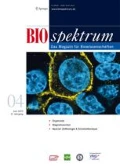Abstract
Although the functions and applications of dipeptides have been poorly studied, compared to proteins or amino acids, their unique properties have long been appreciated. A major obstacle to the industrial production of dipeptides has always been their relatively complicated chemical synthesis. However, novel methods for the economical production of specific dipeptides through biotechnological processes have been developed recently.
Similar content being viewed by others
Literatur
Daniel H, Spanier B, Kottra G et al. (2006) From bacteria to man: archaic proton-dependent peptide transporters at work. Physiology 21:93–102
Yagasaki M, Hashimoto S (2008) Synthesis and application of dipeptides; current status and perspectives. Appl Microbiol Biotechnol 81:13–22
Sallam A, Steinbüchel A (2010) Dipeptides in nutrition and therapy: cyanophycin-derived dipeptides as natural alternatives and their biotechnological production. Appl Microbiol Biotechnol 87:815–828
Sprenger GA (2007) Aromatic amino acids. In: Wendisch VF (Hrsg) Amino acid biosynthesis-pathways, regulation and metabolic engineering. 5. Auflage, Microbiology Monographs. Springer, Berlin. 93–128
Lombard C, Saulnier J, Wallach JM (2005) Recent trends in protease-catalyzed peptide synthesis. Protein Peptide Lett 12:621–629
Fürst P, Pfaender P, Werner F (1985) Glutaminhaltige Aminosäure-Zubereitungen. EP Patent Nr. EP 0087750
Yokozeki K, Hara S (2005) A novel and efficient enzymatic method for the production of peptides from unprotected starting materials. J Biotechnol 115:211–220
Tabata K, Hashimoto S (2007) Fermentative production of L-alanyl-L-glutamine by a metabolically engineered Escherichia coli strain expressing L-amino acid α-ligase. Appl Environ Microbiol 73:6378–6385
Sallam A, Steinbüchel A (2008) Anaerobic and aerobic degradation of cyanophycin by the denitrifying bacterium Pseudomonas alcaligenes strain DIP1 and the role of three other coisolates in a mixed bacterial consortium. Appl Environ Microbiol 74:3434–3443
Sallam A, Steinbüchel A (2009) Cyanophycin-degrading bacteria in digestive tracts of mammals, birds and fish and consequences for possible applications of cyanophycin and its dipeptides in nutrition and therapy. J Appl Microbiol 107:474–484
Sallam A, Kalkandzhiev D, Steinbüchel A (2011) Production optimization of cyanophycinase ChpEal from Pseudomonas alcaligenes DIP1. AMB Express 1:38
Sallam A, Kast A, Przybilla S et al. (2009) Biotechnological process for production of β-dipeptides from cyanophycin at technical scale and its optimization. Appl Environ Microbiol 75:29–38
Author information
Authors and Affiliations
Corresponding author
Additional information
Ahmed Sallam, Martin Krehenbrink, Alexander Steinbüchel (v. l. n. r.)
Rights and permissions
About this article
Cite this article
Sallam, A., Krehenbrink, M. & Steinbüchel, A. Biotechnologische Herstellung von Dipeptiden und deren Anwendungen. Biospektrum 18, 102–104 (2012). https://doi.org/10.1007/s12268-012-0148-1
Published:
Issue Date:
DOI: https://doi.org/10.1007/s12268-012-0148-1




